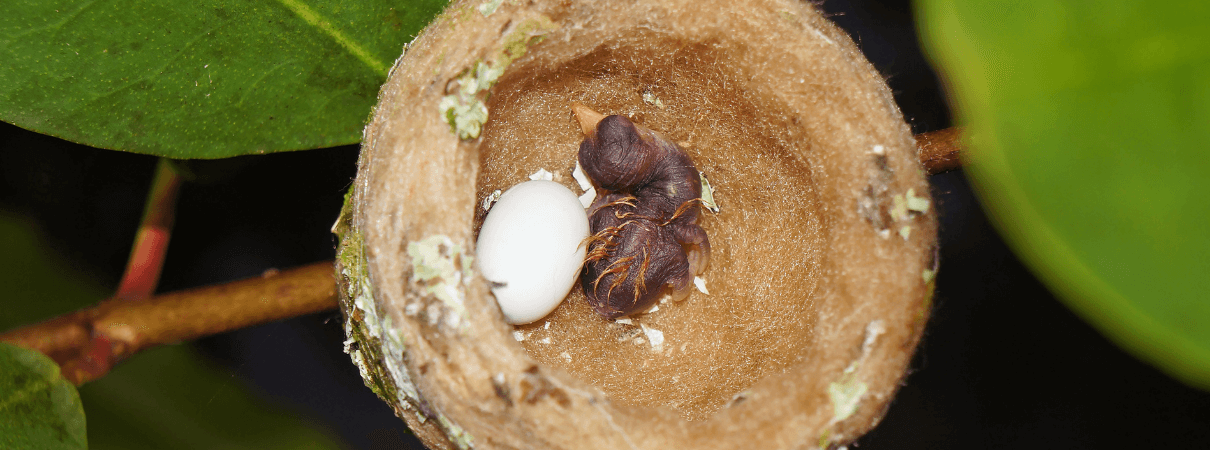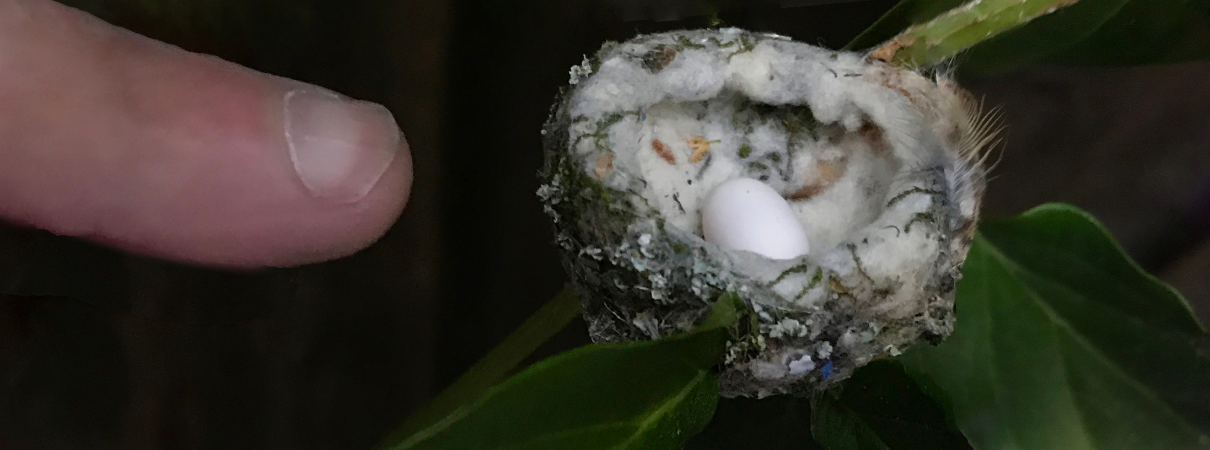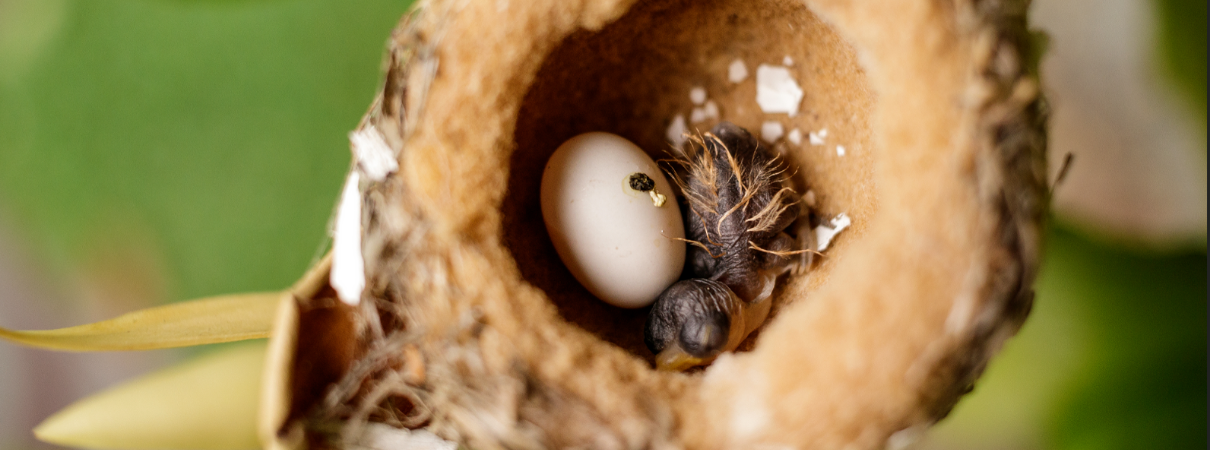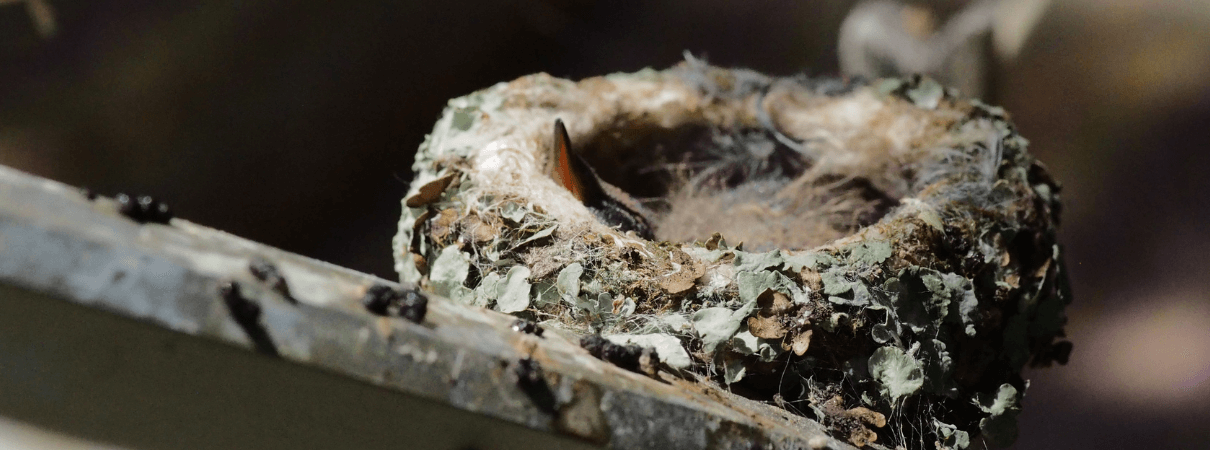Hummingbird Eggs: A Close-Up Look at the World's Smallest Bird Eggs
Hummingbirds may loom large in our minds thanks to their fast and flashy nature, but in truth these birds live life on a small scale — starting with their eggs. Weighing in at less than one-fiftieth of an ounce, hummingbird eggs are easy to overlook, but these tiny wonders deserve our attention.
To learn more, take a look below at our answers to some of the most frequently asked questions about hummingbird eggs and the reproductive cycles of these extraordinary birds.
Don't forget to make it to the bottom where you'll find important tips about how you can help protect hummingbirds.

Hummingbird nest, egg, and hatchling. Photo by Damsea/Shutterstock
How big are hummingbird eggs?
Tiny. Hummingbird eggs are typically compared in size to small jelly beans. However, more than 350 different species of hummingbirds inhabit the Western Hemisphere — the only part of the world they are found — and their eggs vary somewhat in size.
The smallest of hummingbirds, the Bee Hummingbird, found only in Cuba, lays eggs the size of coffee beans. The largest hummingbird, the nine-inch-long Giant Hummingbird, which lives in the Andes and weighs more than a Barn Swallow, lays eggs the length of a penny.
Given their size, it shouldn't be surprising that these eggs don't weigh much. Ruby-throated Hummingbird eggs tip the scales at half a gram, about one-fifth of a penny's weight.

Hummingbird nest and egg, with finger for scale. Photo by Barbara Ash/Shutterstock
How often do hummingbirds lay eggs?
Most hummingbirds lay eggs one to three times each year, depending on the species.
Anna's Hummingbirds, for example, which live and breed in Pacific Coast states, usually have two to three broods annually. This is also the case with some non-migratory hummingbirds living in the tropics that breed several times each year.
Ruby-throated Hummingbirds, which migrate each year, typically have only one brood. But this isn't always the case. If a nest is destroyed early in the breeding season, female Ruby-throats may build another and lay more eggs.

Female Anna's Hummingbird and chicks. Photo by Sen Yang/Shutterstock
How many eggs do hummingbirds lay?
Hummingbirds lay small clutches that range from one to three eggs, although two is the more typical size.
Their eggs may appear miniscule when placed beside those of other birds, but when you factor in the tiny size of adult hummingbirds, they are actually quite large, proportionally speaking.
An American Robin egg, for example, weighs 3.6 percent as much as the adult that laid it. A Ruby-throated Hummingbird's egg, on the other hand, is nearly 17 percent the weight of a mature Ruby-throat.

Hummingbird nest and eggs. Photo by Daniel Lamborn/Shutterstock
When do hummingbirds lay eggs?
The time of year that hummingbirds lay eggs depends on their location.
The Ruby-throated hummingbird, the sole breeding hummingbird in the eastern U.S., typically lays eggs between March and May. The exact date depends on a multitude of factors, not least of which is latitude. If this seems surprising, consider that most Ruby-throated Hummingbirds are migratory, spending winters in Mexico and Central America, and that northern destinations require more travel time and stay cold longer.
In the West, breeding and egg-laying dates vary. Costa's Hummingbird, which is in found throughout the Southwest, lay their eggs from February to June. Rufous Hummingbirds, which breed in the Pacific Northwest, as well as Alaska and Canada, tend to lay their eggs later in the year, usually between April and July.

Hummingbird chick with egg. Photo by Alison Thai/Shutterstock
Where do hummingbirds lay their eggs?
Like many — but not all — bird species, hummingbirds lay their eggs in nests. Woven with spiderweb thread and camouflaged with lichen, these tiny, well-hidden structures measure only a few inches in diameter — making them the smallest bird nests in the world.
To learn more about hummingbird nests, check out another of our posts, “Hummingbird Nests 101: A Beginner's Guide,” which uses photos and video to answers a range of common nest-related questions.

Hummingbird nest and egg. Photo by Leonardo Dantas Teixeira/Shutterstock
How long does it take for hummingbird eggs to hatch?
Before hummingbird chicks can hatch, a period of incubation is required to regulate egg temperature and ensure healthy embryonic development. Depending on the species, this process can last from two to three weeks.
Because males play no part in the incubation process, females pull double duty, responsible for both maintaining eggs and feeding themselves — no little task.
Female Black-chinned Hummingbirds in California balance these needs by embarking on brief but frequent food-gathering trips, usually six to nine times per hour, while nesting.
In the tropics, where lower temperatures are less of a problem, things are easier for incubating females, allowing them to leave nests for longer periods of time.

Male Black-chinned Hummingbird. Photo by Sumikphoto/Shutterstock
What color are hummingbird eggs?
Hummingbird eggs are usually dull white.
Considering the incredible diversity of colors and patterns found on other bird eggs, the fact that these eggs lack pigmentation may tell us something about the impact of sunlight on embryonic hummingbirds.
Researchers believe that egg coloration represents a delicate balancing act: Darker colors protect embryos from harmful UV rays, but also heat faster; lighter colors do the opposite, keeping eggs cooler, but potentially exposing them to greater UV dangers. If so, evolutionary pressure to keep eggs cool may have played a role in producing the white color of modern hummingbirds' eggs.

Hummingbird eggs. Photo by Damsea/Shutterstock
What do you do if you see a hummingbird egg?
Consider yourself lucky if you catch a glimpse of hummingbird eggs — it doesn't happen often. But don't touch!
It is against the law in the U.S. to touch, relocate, or remove active nests.
Apart from legal issues, human visitors can stress out female hummingbirds, which are already juggling multiple needs. Making matters worse, your presence can alert predators, such as jays, to the nest's location.
For these reasons, it's best to keep away from hummingbird nests, observing from a distance with binoculars.

Hummingbird chick in nest. Photo by Jocelyn Freeman/Shutterstock
Do hummingbirds nest in the same place every year?
Migratory hummingbirds often do return to favored nesting grounds annually, but they don't build their nests in the exact same location.
Because their nests are built for one-time use, females need to construct new nests each year, usually in different trees or bushes, but within the same general vicinity.
Hummingbirds' ability to faithfully repeat these long-distance journeys is no small feat — especially considering that they're operating with brains the size of rice grains.
How do they do it? Researchers believe that multiple factors at likely in play. These include the Earth's magnetic field, the sun's location, the use of topographic clues, and perhaps even smell, among other things.
What happens after hummingbird eggs hatch?
Hatchlings emerge from their shells nearly devoid of feathers and with their eyes closed. Unable to stand, these chicks are entirely dependent on their mother for food and warmth. In the weeks that follow, hummingbird chicks quickly develop in preparation for their first flight.
If you'd like to learn more about hummingbird chicks, take a look at our post “From Tiny Egg to Fledgling: Amazing Facts About How Hummingbirds Grow” which provides a great introduction to the fascinating lives of these tiny, rarely seen chicks.

Hummingbird chick. Photo by Jadimages/Shutterstock
What threats do hummingbirds face?
As mentioned above, hummingbird eggs and chicks are vulnerable to predators. Once fledged and out of the nest, hummingbirds face a multitude of human-caused threats. These include window collisions (birds can't see glass), unrestrained outdoor cats, toxic pesticides, and habitat destruction, among other things.
How can I help?
We all can do our part to protect hummingbirds.
American Bird Conservancy and our Joint Venture partners have improved conservation management on 6.4 million acres of U.S. bird habitat — an area larger than the state of Maryland — over the last ten years. This is a monumental undertaking, requiring the support of many, and you can help by making a gift today.
Policies enacted by Congress and federal agencies, such as the U.S. Fish and Wildlife Service, have a huge impact on America's birds. You can help shape these rules for the better by telling lawmakers to prioritize birds, bird habitat, and bird-friendly measures. To get started, visit ABC's Action Center.
Finally, don't overlook the impact you can have at home. If you have a garden, you can help hummingbirds by following eight simple steps, which include adding native flowering plants to your garden and reducing pesticide use.
How ABC is helping hummingbirds
ABC protects hummingbirds throughout their entire life-cycle.
In the U.S., ABC helped establish the Paton Center for Hummingbirds in Arizona, a space that educates the community about these wonderful birds. In Latin America, we work with partners and local communities to ensure there is habitat for the rarest species, including the Marvelous Spatuletail and the Blue-throated Hillstar. We support a reserve network with our partners that spans Latin America, covering more than 1 million acres and helping to protect 234 hummingbird species!
With our partners, ABC also conducts field expeditions to search for new, and monitor known, hummingbird populations. These efforts allow us to detect population changes and to identify new threats or land-use changes that might affect species and their habitats.


















































